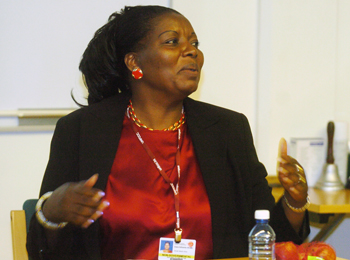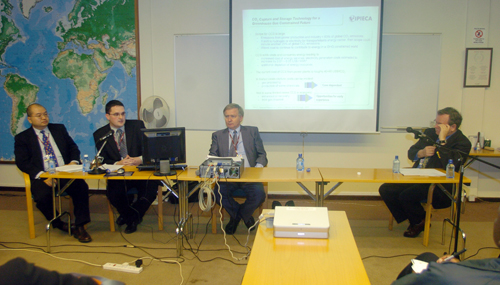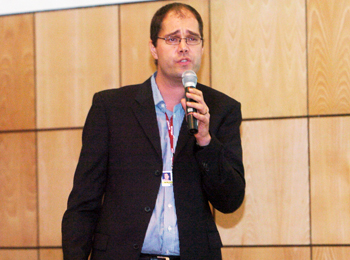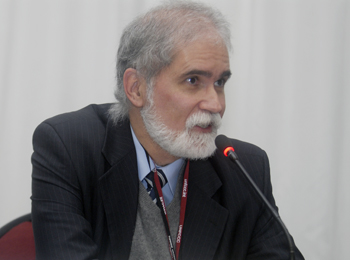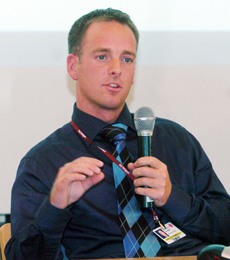 |
||
|
Published by the International Institute for Sustainable Development (IISD)
|
|||
|
A Special Report on Selected Side Events at the Second Conference of the Parties serving as the Meeting of Parties to the Kyoto Protocol (COP/MOP 2) and Twelfth Conference of the Parties (COP 12) to the UN Framework Convention on Climate Change (UNFCCC)
|
|||||
| 6-17 November 2006 | Nairobi, Kenya | |||||
 |
|||
 |
|||
Events convened on Tuesday, 7 November 2006
|
Eco-village as a vehicle for GHG emission reductions and sustainable development Presented by Climate Network Africa |
|||
|
Alfred Omenya, Eco-Build Africa, stated that the eco-village project entails numerous dimensions, including poverty alleviation, livelihoods and affordable housing in the context of adaptation to climate change. He said it is intended as a demonstration project to enable learning about a sustainable model of low-cost housing.
Omenya elaborated that as a mechanism for adaptation to climate change, the project encompasses five aspects: sustainable use of water resources such as domestic rainwater harvesting, stormwater storage, water recycling for flushing toilets and irrigation; sustainable energy use including solar systems for electricity and hot water, natural ventilation, and day lighting, use of energy efficient appliances and light fittings; low-impact building materials such as stabilized earth blocks; permaculture and urban agriculture; and onsite solid waste recycling yards. Omenya indicated that the building layout includes an outer perimeter used for urban agriculture and permaculture, a perimeter running and cycling trail surrounding houses, a shared surface rainwater tank, stormwater recycling and storage and a communal waste management, garbage collection and recycling facility with a biogas digester. A reed bed, which polishes water and renders it fit for reuse for irrigation or sanitation and also to grow valuable biomass products, is included in the design. The building walls are to be made of hydraform, the roofing from profiled aluminum roofing sheets and the glazing from an external layer of double polycarbonate and an internal layer of clear glass. During discussion, a participant sought to know the costs of the units. Omenya explained that although detailed costing was not yet available, a two-bedroom unit is estimated to cost USD 8,300, adding the project is aimed at the low- and middle-income housing market. The organizations involved with the project are non-profit organizations and are using the pilot project to provide an alternative model for low-income groups in peri-urban settings and to influence government policies. |
|||
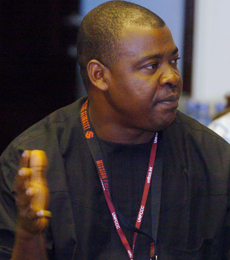 |
 |
 |
||||
|
Damian Ihedioha, United States Agency for International Development
|
Constantino Mendes, The Ecological Youth of Angola Organization
|
|||||
|
|||
|
Impacts of carbon trading on indigenous peoples Presented by ICA |
|||||
|
Anna Pinto, Centre for Organization Research and Education, India, said indigenous peoples must be kept abreast of new terminology regarding carbon trading. She emphasized that indigenous peoples are impacted as much by CDM projects as by climate change. Marcial Arias, Foundation for the Promotion of Indigenous Knowledge, Panama, underscored that CDM projects “overlook” human rights and fundamental principles for indigenous peoples, including their right to self-determination and autonomy to control their own territories and natural resources, and free access to prior informed consent. Diego Alejandro Cardona, CENSAT Agua Viva, explained that Colombia’s Ministry of Environment is carrying out eight CDM projects, which will result in a 150% increase of land dedicated to plantations. He lamented that several of the projects are introducing non-native tree species. Simone Lovera, Global Forest Coalition, described what she called the “carbon trading fraud,” urging participants to consider who wins and loses from carbon trading. She stressed that when the environment is integrated into the economy, the poorest people lose. Sandy Gauntlett, Pacific Indigenous Peoples Environment Coalition, outlined the impacts of plantations on Maori communities in New Zealand. He highlighted the loss of knowledge regarding natural medicines and, to demonstrate the destructive impact of plantations, cited examples of disproportionately high levels of youth suicide and engagement in the sex trade amongst Maoris. A participant noted that some communities in Ecuador would like to examine the potential for carbon trading to improve their livelihoods and preserve their culture, and that carbon trading should be considered on a case-by-case basis. |
|||||
|
|||
|
Carbon capture and storage as a climate change mitigation option Presented by IPIECA |
|||||
|
Brian Flannery, ExxonMobil, introduced the activities of the International Petroleum Industry Environmental Conservation Association (IPIECA) and its work on developing inventory guidelines for emission reductions through carbon capture and storage (CCS).
Luke Warren, IPIECA, presented a summary of a 2006 IPIECA workshop held to advance CCS understanding, highlighting some of the key issues, including the projected high increases in energy demands by 2060 and the large scope offered by CCS in mitigation. He said that CCS needs massive new infrastructure investment while other projects such as enhanced oil recovery bear modest costs. He emphasized the absence of sound legal and regulatory frameworks as a barrier for further deployment of CCS. Frede Cappelen, Statoil ASA, elaborated on IPIECA’s ongoing work on guidelines for CCS emission reductions projects, and underscored that emissions should be calculated and monitored along the whole CCS chain. He indicated that the guidelines will soon be available for peer review. Highlighting the results of an IPIECA roundtable on CCS held in May 2006, Arthur Lee, Chevron, discussed issues relating to policy and regulatory frameworks, noting the importance of long-term liability of CCS, monitoring of CCS emissions and the problems with classification of carbon dioxide as a waste product. Summarizing the key points of the discussion, Flannery suggested that for CCS to achieve its potential, there is a need for participation of players beyond the oil and gas industry. Participants discussed issues relating to delabelling carbon dioxide as a waste product and the long-term stability of CCS projects. |
|||||
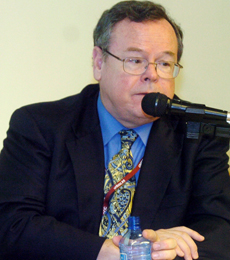 |
 |
 |
|||||
|
Brian Flannery, ExxonMobil
|
Arthur Lee, Chevron
|
Frede Cappelen, Statoil ASA
|
|||||
|
|||
|
Smarter development through better decision making in forestry and electricity Presented by WRI |
|||
|
Suzie Greenhalgh, World Resources Institute (WRI), presented the Land Use, Land-Use Change, and Forestry (LULUCF) Guidance Tool for GHG Project Accounting (LULUCF Guidance), which has four parts: concepts and principles; GHG reduction accounting and reporting; an example which applies guidance to a real project; and annexes.
Florence Daviet, WRI, described the chapters on accounting and reporting of GHG reductions from LULUCF projects. Timm Tennigkeit, Unique Forestry Consultants, outlined barriers and opportunities for LULUCF projects in East Africa. He said that the main barriers include inequitable access to loans for LULUCF projects, high project development costs and the lack of political and financial incentives. Tennigkeit noted that countries in the East African region are gifted in natural bounties and have a high potential for ecotourism development and timber and biopower production. David Neil Bird, Joanneum Institute of Energy Research, noted that the LULUCF guidance tool is a step towards a landscape-based approach that could be used to avoid deforestation and ensure reduced emissions from degradation. Smita Nakhooda, WRI, outlined the Electricity Governance Initiative, noting that there are urgent challenges in transitioning to clean energy and improving energy access to the poorest. She highlighted governance obstacles such as closed decision-making processes, inadequate consideration of public concerns and the adoption of untested reform prescriptions. She indicated that the Electricity Governance Initiative seeks to contribute to improved communication among stakeholders and develop an operational framework to assess governance and help identify best practices. |
|||
|
|||
|
CDM Executive Board: question and answer session Presented by UNFCCC |
|||
|
José Domingos Miguez, Chair of the Clean Development Mechanism (CDM) Executive Board (EB), summarized EB’s activities, underscoring that 398 CDM projects have been implemented and that more than 1,200 projects are in the pipeline. He informed that a total of 670 million Certified Emission Reductions (CERs) are expected to be registered by 2012.
Andrei Marcu, President of the International Emissions Trading Association (IETA), suggested some recommendations to EB, including: avoiding new layers of bureaucracy; subcontracting reputable engineering consultants to address issues on new technologies and methodologies; ensuring consistency; and further enhancing communication and transparency. Einar Telnes, Det Norske Veritas (DNV), Chair of Designated Operational Entity and Applicant Entity (DOE/AE) Coordination Forum, noted that the interaction between DOE/AE and EB has progressed but called for further communication with, and guidance from, EB on a variety of operational issues. William Agyemang-Bonsu, Co-Chair of the Designated National Authority (DNA) Forum, said the Forum offers the opportunity for DNAs to share experiences and identify common issues to be addressed with EB. Lucy Naydenova, DNA Forum Co-Chair, expressed hope that the DNA Forum will assist countries that have not established their DNAs to do so promptly. R. K. Sethi, Chair of the Meth Panel, said the Secretariat’s process on addressing new technologies and methodologies are well established. Hernan Carlino, Chair of the Accreditation Panel, underscored the importance of DOE’s work in ensuring the integrity of the CDM as a market mechanism. Responding to numerous questions from the audience, Miguez noted that: EB tries to be as transparent as possible, respecting the need for confidentiality; and that requirements regarding the eligibility of land in afforestation and reforestation projects and parallel CDM regulations and human rights of indigenous people are issues to be addressed under the COP/MOP and not in a CDM question-and-answer session. |
|||
|
|||
|
European Capacity Building Initiative Presented by the European Union |
|||
|
Benito Müller, Oxford Climate Policy, underscored that the European Capacity Building Initiative aims to enhance developing country delegates’ capacity to effectively participate in UNFCCC negotiations.
Bubu Jallow, The Gambia, presented a paper on operationalizing the adaptation fund (AF), and concluded that the decision making process of the AF must be flexible, transparent, “easy to access,” and reflect developing country needs. Saleemul Huq, International Institute for Environment and Development, outlined the Initiative’s workshop programme that promotes capacity building on negotiation skills and strategies for climate delegates from developing countries. He noted that the programme includes pre-conference workshops for the Least Developed Countries (LDCs) that take place two days prior to COPs. Amjad Abdulla, Ministry of Environmental Energy, Maldives, outlined the National Adaptation Plan of Action (NAPA) of the Maldives. He summarized key priorities, including the need to: continue implementation of adaptation activities and coastal protection; establish multi-hazard early warning systems; protect coral reef resources; and promote economic diversification. Thomas Downing, Stockholm Environment Institute, reviewed the preliminary results of his organizations’ work on compiling NAPA experiences in Eastern and Southern Africa, including that: NAPAs have created awareness and sense of ownership among countries’ stakeholders; and further delays in implementing urgent adaptation measures could increase current vulnerability or result in increased costs for implementation. K. Umamaheswaran, Hamburg Institute of International Economics, presented a study on assessing CDM projects and implementation barriers faced by LDCs in Asia. He noted that Malaysia, Thailand and Indonesia hold the largest number of CDM projects in the region, and these focus mainly on agricultural waste, biomass and waste water. Umamaheswaran stressed that DNAs are still to be established in Singapore and Lao. |
|||
|
|||
|
Global status and outlook for nuclear power Presented by IAEA |
|||
|
Alan Mc Donald, International Atomic Energy Agency (IAEA), noted that expectations with regards to nuclear power are rising and that its cost relative to other energy options will dictate whether those expectations are met. He stressed that the attractiveness of nuclear power is dependent on a range of factors, and that it is most suited to countries where: energy demand is growing rapidly; alternative resources are scarce; reducing air pollution and GHGs and promoting energy security are priorities; financing can look long-term; and financial risk is low.
Hans-Holger Rogner, IAEA, emphasized that exclusion of any technology with clear climate benefits from climate change agreements limits options, flexibility and competitiveness and stressed that all energy options should be measured on a “level playing field” based on cost-effectiveness, GHG-reduction potential, environmental and health protection, security and safety. Per Jander, World Nuclear Association, noted that uranium is not a scarce resource and that it can be found in most parts of the world, including Africa. He explained that the number of mining and exploration companies is rapidly increasing and that technological improvements will result in new sources being found. Phumzile Tshelane, Eskom Generation, said Eskom is looking for the optimal mix of energy sources in Southern Africa, explaining that nuclear makes an important contribution because it is less costly than coal, mitigates electricity power line losses and helps remote regions connect to the grid. Participants discussed: the prospects of nuclear fuel leasing processes, solutions for high-level nuclear waste, safety, proliferation, and the environmental impacts of nuclear waste relative to carbon dioxide emissions. |
|||
 |
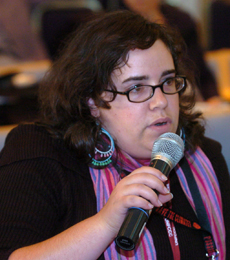 |
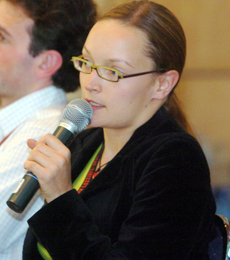 |
|||||
|
Suresh Patel, Agrochemicals Manufacture, Saro Limited
|
Maya Aberman, Earthlife Africa - Cape Town
|
Kaisa Kosonen, Greenpeace
|
|||||
|
|||
|
||
|
Click the above button to go back to our ENB main coverage
|
||
|
|
|
|
|
||
|
